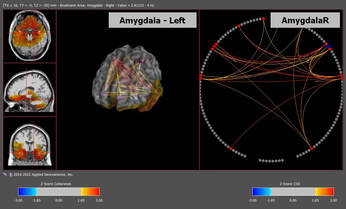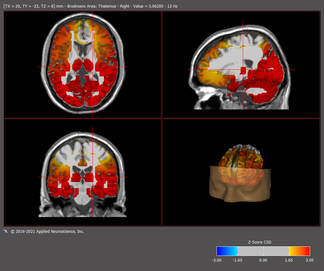 NeuroNavigator swLORETA analysis shows dysregulation in the amygdala and other areas of the brain of this anxious patient treated at my office. NeuroNavigator swLORETA analysis shows dysregulation in the amygdala and other areas of the brain of this anxious patient treated at my office. Some anxiety is a normal part of life. But when anxiety levels increase to a point that it interferes with someone's health and happiness, help is out there. One of the therapies I used for anxiety is Neurofeedback. The first step is to utilize quantitative electroencephalography (qEEG) and do a brain map to identify the parts of the brain that are not functioning efficiently. Neurofeedback can then be used to retrain those dysregulated areas of the brain. When this is done, symptoms go away. In my office, patients report these changes to be permanent and I some of them years after treatment as they may choose to also pursue chiropractic care with me or may have been an existing chiropractic patient before Neurofeedback. More recent research has shown that there is an anxiety network in the brain. Different areas of the brain can be involved. These include the amygdala, the insula, the middle frontal gyrus and superior parietal lobule. For conditions like OCD, the anterior cingulate, cingulate, and orbitofrontal gyrus should be considered. PTSD includes other regions. There are other areas that may be involved, depending on patient symptoms. Do you or someone you know have anxiety? They may have dysregulation in these areas of the brain. The good news is there is treatment for this including Neurofeedback. I also do traditional psychotherapy and EMDR in my office, which may be more appropriate, especially if the anxiety does not have a brain basis. This is all part of the comprehensive analysis and diagnosis done at Tuttle Health, LLC in Palm Harbor, Florida.
0 Comments
 swLORETA map of a patient with an Anxiety Disorder and ADHD showing excessive alpha activity in the thalamus and other areas of the brain related to presenting symptoms. swLORETA map of a patient with an Anxiety Disorder and ADHD showing excessive alpha activity in the thalamus and other areas of the brain related to presenting symptoms. Neurofeedback works on the brain. Through pioneering research I developed, I have been able to show that the technique of chiropractic I use, Sacro Occipital Technique, also affects brain function. Many "brain problems" that result in conditions like ADHD, ADD, PTSD, OCD, Traumatic Brain Injury, insomnia, depression and anxiety can be viewed as a brain being "stuck" in a physiological pattern that needs to be disrupted to change. Adding chiropractic to a Neurofeedback program, adds another way to disrupt old patterns and introduce new ones. For much of its history, Neurofeedback used one or two electrodes placed on the head. I have successfully treated many patients with this form of Neurofeedback. However, not all patients are the same. Sometimes Neurofeedback with one or two electrodes isn't what the patient needs to reach their treatment goals. For this reason, I have invested in additional technologies and forms of Neurofeedback. These include:
 Research I conducted showed that SOT® blocks placed under the pelvis resulted in changes in brain activity suggesting enhancement of neuroplasticity. Research I conducted showed that SOT® blocks placed under the pelvis resulted in changes in brain activity suggesting enhancement of neuroplasticity.
You have a choice as to who provides you therapy. With this variety tools in my toolbox, I can create an individualized treatment plan to help you reach your treatment goals as quickly and effectively as possible. |
AuthorI'm a Chiropractic Physician, Psychotherapist and researcher. I'm interested in helping people live their lives to their full potential. That could be simply without pain. Or it could be without more complicated physical or mental health problems. Or it could be getting help in making changes in their life so that they can achieve their dreams. Archives
June 2023
Categories |
 RSS Feed
RSS Feed